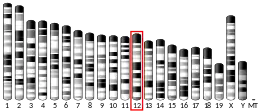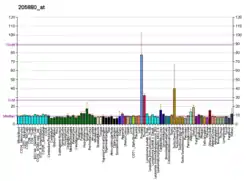Protein kinase D1
Serine/threonine-protein kinase D1 is an enzyme that in humans is encoded by the PRKD1 gene.[5][6][7]
Function
Members of the protein kinase D (PKD) family function in many extracellular receptor-mediated signal transduction pathways. The PRKCM gene encodes a cytosolic serine-threonine kinase that binds to the trans-Golgi network and regulates the fission of transport carriers specifically destined to the cell surface.[supplied by OMIM][7]
Interactions
Protein kinase D1 has been shown to interact with:
References
- GRCh38: Ensembl release 89: ENSG00000184304 - Ensembl, May 2017
- GRCm38: Ensembl release 89: ENSMUSG00000002688 - Ensembl, May 2017
- "Human PubMed Reference:". National Center for Biotechnology Information, U.S. National Library of Medicine.
- "Mouse PubMed Reference:". National Center for Biotechnology Information, U.S. National Library of Medicine.
- Johannes FJ, Prestle J, Eis S, Oberhagemann P, Pfizenmaier K (April 1994). "PKCu is a novel, atypical member of the protein kinase C family". J Biol Chem. 269 (8): 6140–8. doi:10.1016/S0021-9258(17)37580-4. PMID 8119958.
- Owczarek CM, Portbury KJ, Kola I, Hertzog PJ (September 2000). "Assignment of protein kinase C mu (PRKCM) to human chromosome band 14q11 with somatic cell hybrids and radiation hybrids". Cytogenet Cell Genet. 89 (3–4): 240–1. doi:10.1159/000015624. PMID 10965134. S2CID 26620985.
- "Entrez Gene: PRKD1 protein kinase D1".
- Johannes FJ, Hausser A, Storz P, Truckenmüller L, Link G, Kawakami T, Pfizenmaier K (November 1999). "Bruton's tyrosine kinase (Btk) associates with protein kinase C mu". FEBS Lett. 461 (1–2): 68–72. doi:10.1016/s0014-5793(99)01424-6. PMID 10561498.
- Storz P, Hausser A, Link G, Dedio J, Ghebrehiwet B, Pfizenmaier K, Johannes FJ (August 2000). "Protein kinase C [micro] is regulated by the multifunctional chaperon protein p32". J. Biol. Chem. 275 (32): 24601–7. doi:10.1074/jbc.M002964200. PMID 10831594.
- Zemlickova E, Dubois T, Kerai P, Clokie S, Cronshaw AD, Wakefield RI, Johannes FJ, Aitken A (August 2003). "Centaurin-alpha(1) associates with and is phosphorylated by isoforms of protein kinase C". Biochem. Biophys. Res. Commun. 307 (3): 459–65. doi:10.1016/s0006-291x(03)01187-2. PMID 12893243.
- Rao PS, Jaggi M, Smith DJ, Hemstreet GP, Balaji KC (October 2003). "Metallothionein 2A interacts with the kinase domain of PKCmu in prostate cancer". Biochem. Biophys. Res. Commun. 310 (3): 1032–8. doi:10.1016/j.bbrc.2003.09.118. PMID 14550308.
- Hausser A, Storz P, Link G, Stoll H, Liu YC, Altman A, Pfizenmaier K, Johannes FJ (April 1999). "Protein kinase C mu is negatively regulated by 14-3-3 signal transduction proteins". J. Biol. Chem. 274 (14): 9258–64. doi:10.1074/jbc.274.14.9258. PMID 10092600.
Further reading
- Van Lint J, Rykx A, Maeda Y, Vantus T, Sturany S, Malhotra V, Vandenheede JR, Seufferlein T (2002). "Protein kinase D: an intracellular traffic regulator on the move". Trends Cell Biol. 12 (4): 193–200. doi:10.1016/S0962-8924(02)02262-6. PMID 11978539.
- Busch H, Eisenhart-Rothe BV (1976). "[Old and new dangers of blood transfusion (author's transl)]". Münchener medizinische Wochenschrift. 118 (22): 713–8. PMID 5668.
- Jakobovits A, Rosenthal A, Capon DJ (1990). "Trans-activation of HIV-1 LTR-directed gene expression by tat requires protein kinase C". EMBO J. 9 (4): 1165–70. doi:10.1002/j.1460-2075.1990.tb08223.x. PMC 551792. PMID 2182321.
- Davis RJ, Czech MP (1985). "Tumor-promoting phorbol diesters cause the phosphorylation of epidermal growth factor receptors in normal human fibroblasts at threonine-654". Proc. Natl. Acad. Sci. U.S.A. 82 (7): 1974–8. Bibcode:1985PNAS...82.1974D. doi:10.1073/pnas.82.7.1974. PMC 397463. PMID 2984676.
- Davis RJ, Czech MP (1985). "Platelet-derived growth factor mimics phorbol diester action on epidermal growth factor receptor phosphorylation at threonine-654". Proc. Natl. Acad. Sci. U.S.A. 82 (12): 4080–4. Bibcode:1985PNAS...82.4080D. doi:10.1073/pnas.82.12.4080. PMC 397938. PMID 2987962.
- Conant K, Ma M, Nath A, Major EO (1996). "Extracellular human immunodeficiency virus type 1 Tat protein is associated with an increase in both NF-kappa B binding and protein kinase C activity in primary human astrocytes". J. Virol. 70 (3): 1384–9. doi:10.1128/JVI.70.3.1384-1389.1996. PMC 189957. PMID 8627654.
- Sidorenko SP, Law CL, Klaus SJ, Chandran KA, Takata M, Kurosaki T, Clark EA (1996). "Protein kinase C mu (PKC mu) associates with the B cell antigen receptor complex and regulates lymphocyte signaling". Immunity. 5 (4): 353–63. doi:10.1016/S1074-7613(00)80261-7. PMID 8885868.
- Holmes AM (1996). "In vitro phosphorylation of human immunodeficiency virus type 1 Tat protein by protein kinase C: evidence for the phosphorylation of amino acid residue serine-46". Arch. Biochem. Biophys. 335 (1): 8–12. doi:10.1006/abbi.1996.0476. PMID 8914829.
- Borgatti P, Zauli G, Cantley LC, Capitani S (1998). "Extracellular HIV-1 Tat protein induces a rapid and selective activation of protein kinase C (PKC)-alpha, and -epsilon and -zeta isoforms in PC12 cells". Biochem. Biophys. Res. Commun. 242 (2): 332–7. doi:10.1006/bbrc.1997.7877. PMID 9446795.
- Zidovetzki R, Wang JL, Chen P, Jeyaseelan R, Hofman F (1998). "Human immunodeficiency virus Tat protein induces interleukin 6 mRNA expression in human brain endothelial cells via protein kinase C- and cAMP-dependent protein kinase pathways". AIDS Res. Hum. Retroviruses. 14 (10): 825–33. doi:10.1089/aid.1998.14.825. PMID 9671211.
- Waldron RT, Iglesias T, Rozengurt E (1999). "The pleckstrin homology domain of protein kinase D interacts preferentially with the eta isoform of protein kinase C". J. Biol. Chem. 274 (14): 9224–30. doi:10.1074/jbc.274.14.9224. PMID 10092595.
- Hausser A, Storz P, Link G, Stoll H, Liu YC, Altman A, Pfizenmaier K, Johannes FJ (1999). "Protein kinase C mu is negatively regulated by 14-3-3 signal transduction proteins". J. Biol. Chem. 274 (14): 9258–64. doi:10.1074/jbc.274.14.9258. PMID 10092600.
- Jamora C, Yamanouye N, Van Lint J, Laudenslager J, Vandenheede JR, Faulkner DJ, Malhotra V (1999). "Gbetagamma-mediated regulation of Golgi organization is through the direct activation of protein kinase D". Cell. 98 (1): 59–68. doi:10.1016/S0092-8674(00)80606-6. PMID 10412981.
- Bagowski CP, Stein-Gerlach M, Choidas A, Ullrich A (1999). "Cell-type specific phosphorylation of threonines T654 and T669 by PKD defines the signal capacity of the EGF receptor". EMBO J. 18 (20): 5567–76. doi:10.1093/emboj/18.20.5567. PMC 1171625. PMID 10523301.
- Johannes FJ, Hausser A, Storz P, Truckenmüller L, Link G, Kawakami T, Pfizenmaier K (1999). "Bruton's tyrosine kinase (Btk) associates with protein kinase C mu". FEBS Lett. 461 (1–2): 68–72. doi:10.1016/S0014-5793(99)01424-6. PMID 10561498.
- Storz P, Hausser A, Link G, Dedio J, Ghebrehiwet B, Pfizenmaier K, Johannes FJ (2000). "Protein kinase C [micro] is regulated by the multifunctional chaperon protein p32". J. Biol. Chem. 275 (32): 24601–7. doi:10.1074/jbc.M002964200. PMID 10831594.
- Mayne M, Holden CP, Nath A, Geiger JD (2000). "Release of calcium from inositol 1,4,5-trisphosphate receptor-regulated stores by HIV-1 Tat regulates TNF-alpha production in human macrophages". J. Immunol. 164 (12): 6538–42. doi:10.4049/jimmunol.164.12.6538. PMID 10843712.
- Matthews SA, Iglesias T, Rozengurt E, Cantrell D (2000). "Spatial and temporal regulation of protein kinase D (PKD)". EMBO J. 19 (12): 2935–45. doi:10.1093/emboj/19.12.2935. PMC 203351. PMID 10856238.
- Vertommen D, Rider M, Ni Y, Waelkens E, Merlevede W, Vandenheede JR, Van Lint J (2000). "Regulation of protein kinase D by multisite phosphorylation. Identification of phosphorylation sites by mass spectrometry and characterization by site-directed mutagenesis". J. Biol. Chem. 275 (26): 19567–76. doi:10.1074/jbc.M001357200. PMID 10867018.
This article is issued from Wikipedia. The text is licensed under Creative Commons - Attribution - Sharealike. Additional terms may apply for the media files.




